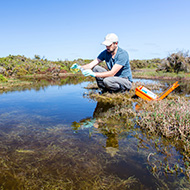Scientists discover cause of mysterious elephant deaths
The infection may have been spread by elephants socialising.
Scientists from the University of Surrey have helped to link the deaths of over 380 elephants to the outbreak of a septicaemic infection.
The infection, caused by a little-known bacteria, is believed to have spread across endangered African savanna elephants in Botswana and Zimbabwe in the space of just five months.
The investigation was launched after the mysterious deaths of 35 elephants in Zimbabwe between August and September 2020. This had followed 350 mortalities in neighbouring northern Botswana in May and June 2020.
This could have a serious impact on the future of the endangered species, which is on the International Union for Conservation of Nature red list with only 350,000 African savanna elephants remaining.
African savanna elephants are already seeing deaths occur at an alarming rate, with eight per cent of the population dying per year.
Researchers from the University of Surrey, the Animal and Plant Health Agency UK, the Victoria Falls Wildlife Trust and laboratories in South Africa began to study what had caused these latest deaths. This involved conducting post mortems of the elephants on-site.
The research team quickly discounted that these deaths had been the result of poachers, who have been known to kill elephants in the area for their ivory, as the elephants still had their tusks.
Suggestions that the elephants had been poisoned were also disproved after toxicology reports found no signs of cyanide in their bodies or watering holes.
However they had a breakthrough when they discovered a septicaemic infection caused by a little-known bacteria, preliminarily called Bisgaard taxon 45.
The presence of Bisgaard taxon 45, an unclassified member of the Pasteurellaceae bacterial family, was confirmed in six elephants through bacterial isolation and genetic analysis. Pasteurella bacteria has previously been associated with the sudden deaths of wild antelope, but not in elephants prior to the study.
It is theorised that the social nature of elephants may have contributed to the transmission of this bacteria, particularly in connection to stress caused by extreme weather events, such as drought.
Dr Arnoud van Vliet, senior lecturer in veterinary microbiology at the University of Surrey’s School of Veterinary Sciences said: “The international composition of our research team highlights the opportunities arising for conservation investigations into the disease and death of free-ranging animals.
“Bisgaard taxon 45 has never before been associated with bacterial septicaemia and it adds to the growing list of disease related threats to elephant conservation.”
The full study will be published in the journal Nature Communications.
Image © Shutterstock



 A set of international guidelines for disease surveillance in wildlife has been updated for the first time since 2015.
A set of international guidelines for disease surveillance in wildlife has been updated for the first time since 2015.